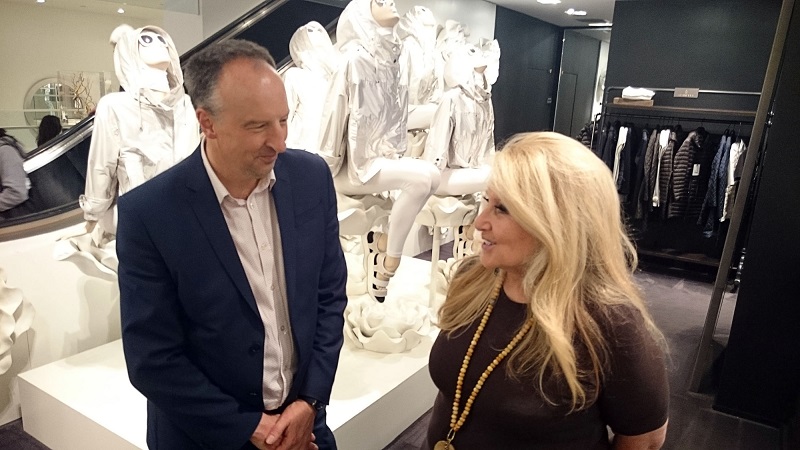A Day in the Life of Andy Warhol, BBC Four | reviews, news & interviews
A Day in the Life of Andy Warhol, BBC Four
A Day in the Life of Andy Warhol, BBC Four
24 hours in the king of Pop Art's shoes

It was suggested more than once during this adventure in Warhol-world that Andy Warhol himself was the artist’s greatest achievement. It’s a neat sentiment if not an original one, and while it may well be true, it didn’t bode well for a documentary in search of the “real” Andy Warhol.
In the event, however, the whole thing was so thoroughly entertaining that such objections seemed prissy and unsporting, encounters with an array of aged Factory regulars providing a rare hour of fun. Presenter Stephen Smith, usually at home on Newsnight, maintained an air of good-humoured scepticism pretty much throughout, keeping the whole thing well clear of hagiography.
There were occasional glimpses of a more vulnerable, recognisably human character
Even so, as Smith’s “24 hours in Andy-time” got started just after midnight with Warhol shooting one of his most notorious films, a five-hour marathon featuring his friend and lover John Giorno fast asleep, Smith seemed momentarily overwhelmed. Meeting Giorno and his now legendary bed, Smith enquired: “Would it be OK for me to touch the storied bed? I don’t need gloves?” Giorno was tickled pink, replying: “Touch it, do anything that you want to”. Sure enough, Smith crouched down to prod the mattress, mumbling something about checking it for springiness.
While Warhol himself was finally sleeping – a minor miracle according to Giorno, who said he “took speed by the handful” – in the townhouse he shared with his mother and two dozen Siamese cats, Gerard Malanga, “the Factory stud”, was slaving away on $1.25 an hour, working on the silkscreen prints for which Warhol is perhaps best known today. Smith’s meeting with Malanga in a New York bistro was fascinating, not least because it demonstrated all too vividly how even the wildest of youths must submit, eventually, to cholesterol problems and early bedtimes (main picture).
It was difficult to get the measure of Malanga, who was by turns frank and evasive, describing his paltry wages as “embarrassing” but deftly outmanoeuvring his interviewer when asked whether his contribution to the Warhol project had been properly acknowledged. Malanga was far from alone in his loyalty to Warhol, and the all-too predictable comparison between Warhol’s Factory and a king holding court seemed hard to refute.
 Time and again his old associates leapt to his defence. “Little Joey” Freeman, the youngest member of the Factory, employed by Warhol to get him out of bed at around lunchtime every day, described how he lost weight to fit in with the Factory’s “ideal”, but denied that there was any pressure to do so. Jane Holzer (pictured above), whose appearance in 11 of Warhol’s Screen Tests rescued her from life as a bored housewife, dismissed the suggestion that Warhol dropped stars as quickly as he created them.
Time and again his old associates leapt to his defence. “Little Joey” Freeman, the youngest member of the Factory, employed by Warhol to get him out of bed at around lunchtime every day, described how he lost weight to fit in with the Factory’s “ideal”, but denied that there was any pressure to do so. Jane Holzer (pictured above), whose appearance in 11 of Warhol’s Screen Tests rescued her from life as a bored housewife, dismissed the suggestion that Warhol dropped stars as quickly as he created them.
For all this, there were occasional glimpses of a more vulnerable, recognisably human character, and Warhol’s reliance on the opinions, ideas and reassurance of those around him was made apparent. One of his closest confidantes was Brigid Berlin, whose lengthy and bizarre phone-calls with Warhol were recreated for the camera: “Everyone thinks Andy was so quiet. Well I can contradict that perfectly, because he never shut up.” Warhol’s nephew, strikingly similar in appearance to his uncle, described how the artist had a crucifix above his bed, his regular attendance at church part of a private homelife that he kept strictly separate from his life as an artist.
As Smith finished the day embroiled in another night-time filming stint, it was hard to say whether we had really learned much at all about the "real" Andy Warhol. What was clear though, was that this hardly seemed to matter. Real or not, is there ever likely to be a more compelling figure than Andy Warhol?
rating
Share this article
The future of Arts Journalism
You can stop theartsdesk.com closing!
We urgently need financing to survive. Our fundraising drive has thus far raised £49,000 but we need to reach £100,000 or we will be forced to close. Please contribute here: https://gofund.me/c3f6033d
And if you can forward this information to anyone who might assist, we’d be grateful.

Subscribe to theartsdesk.com
Thank you for continuing to read our work on theartsdesk.com. For unlimited access to every article in its entirety, including our archive of more than 15,000 pieces, we're asking for £5 per month or £40 per year. We feel it's a very good deal, and hope you do too.
To take a subscription now simply click here.
And if you're looking for that extra gift for a friend or family member, why not treat them to a theartsdesk.com gift subscription?
more TV
 Murder Before Evensong, Acorn TV review - death comes to the picturesque village of Champton
The Rev Richard Coles's sleuthing cleric hits the screen
Murder Before Evensong, Acorn TV review - death comes to the picturesque village of Champton
The Rev Richard Coles's sleuthing cleric hits the screen
 Black Rabbit, Netflix review - grime and punishment in New York City
Jude Law and Jason Bateman tread the thin line between love and hate
Black Rabbit, Netflix review - grime and punishment in New York City
Jude Law and Jason Bateman tread the thin line between love and hate
 The Hack, ITV review - plodding anatomy of twin UK scandals
Jack Thorne's skill can't disguise the bagginess of his double-headed material
The Hack, ITV review - plodding anatomy of twin UK scandals
Jack Thorne's skill can't disguise the bagginess of his double-headed material
 Slow Horses, Series 5, Apple TV+ review - terror, trauma and impeccable comic timing
Jackson Lamb's band of MI5 misfits continues to fascinate and amuse
Slow Horses, Series 5, Apple TV+ review - terror, trauma and impeccable comic timing
Jackson Lamb's band of MI5 misfits continues to fascinate and amuse
 Coldwater, ITV1 review - horror and black comedy in the Highlands
Superb cast lights up David Ireland's cunning thriller
Coldwater, ITV1 review - horror and black comedy in the Highlands
Superb cast lights up David Ireland's cunning thriller
 Blu-ray: The Sweeney - Series One
Influential and entertaining 1970s police drama, handsomely restored
Blu-ray: The Sweeney - Series One
Influential and entertaining 1970s police drama, handsomely restored
 I Fought the Law, ITVX review - how an 800-year-old law was challenged and changed
Sheridan Smith's raw performance dominates ITV's new docudrama about injustice
I Fought the Law, ITVX review - how an 800-year-old law was challenged and changed
Sheridan Smith's raw performance dominates ITV's new docudrama about injustice
 The Paper, Sky Max review - a spinoff of the US Office worth waiting 20 years for
Perfectly judged recycling of the original's key elements, with a star turn at its heart
The Paper, Sky Max review - a spinoff of the US Office worth waiting 20 years for
Perfectly judged recycling of the original's key elements, with a star turn at its heart
 The Guest, BBC One review - be careful what you wish for
A terrific Eve Myles stars in addictive Welsh mystery
The Guest, BBC One review - be careful what you wish for
A terrific Eve Myles stars in addictive Welsh mystery
 theartsdesk Q&A: Suranne Jones on 'Hostage', power pants and politics
The star and producer talks about taking on the role of Prime Minister, wearing high heels and living in the public eye
theartsdesk Q&A: Suranne Jones on 'Hostage', power pants and politics
The star and producer talks about taking on the role of Prime Minister, wearing high heels and living in the public eye
 King & Conqueror, BBC One review - not many kicks in 1066
Turgid medieval drama leaves viewers in the dark
King & Conqueror, BBC One review - not many kicks in 1066
Turgid medieval drama leaves viewers in the dark
 Hostage, Netflix review - entente not-too-cordiale
Suranne Jones and Julie Delpy cross swords in confused political drama
Hostage, Netflix review - entente not-too-cordiale
Suranne Jones and Julie Delpy cross swords in confused political drama

Add comment